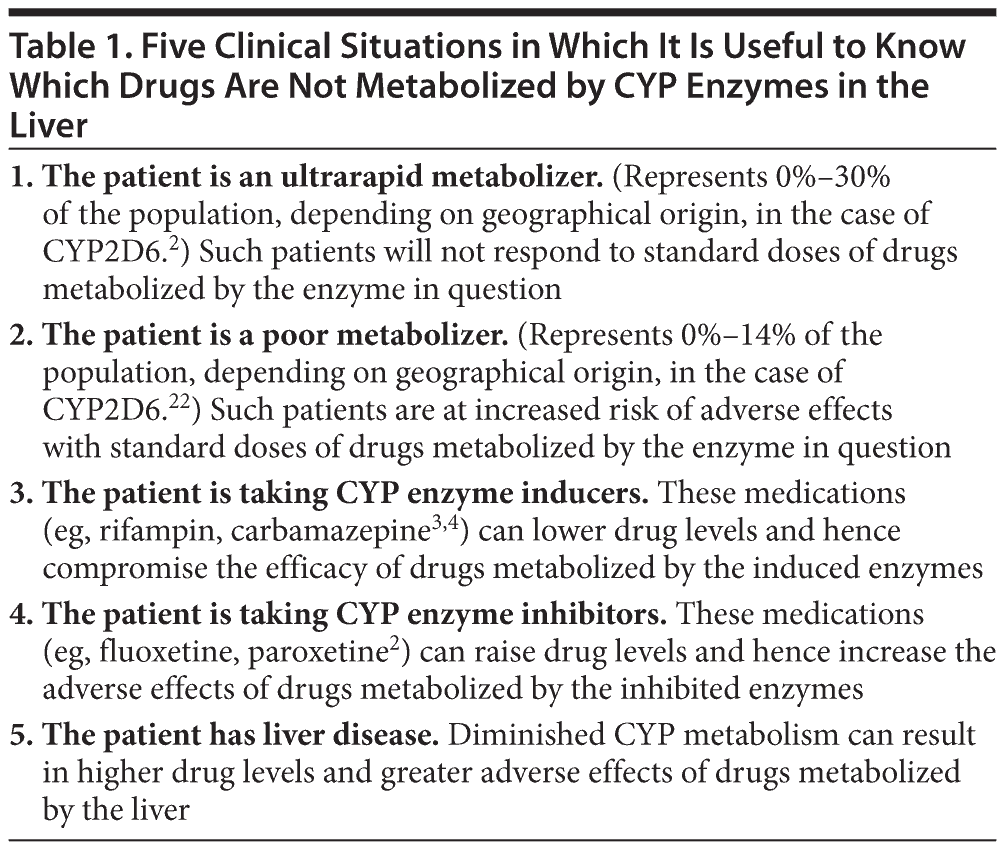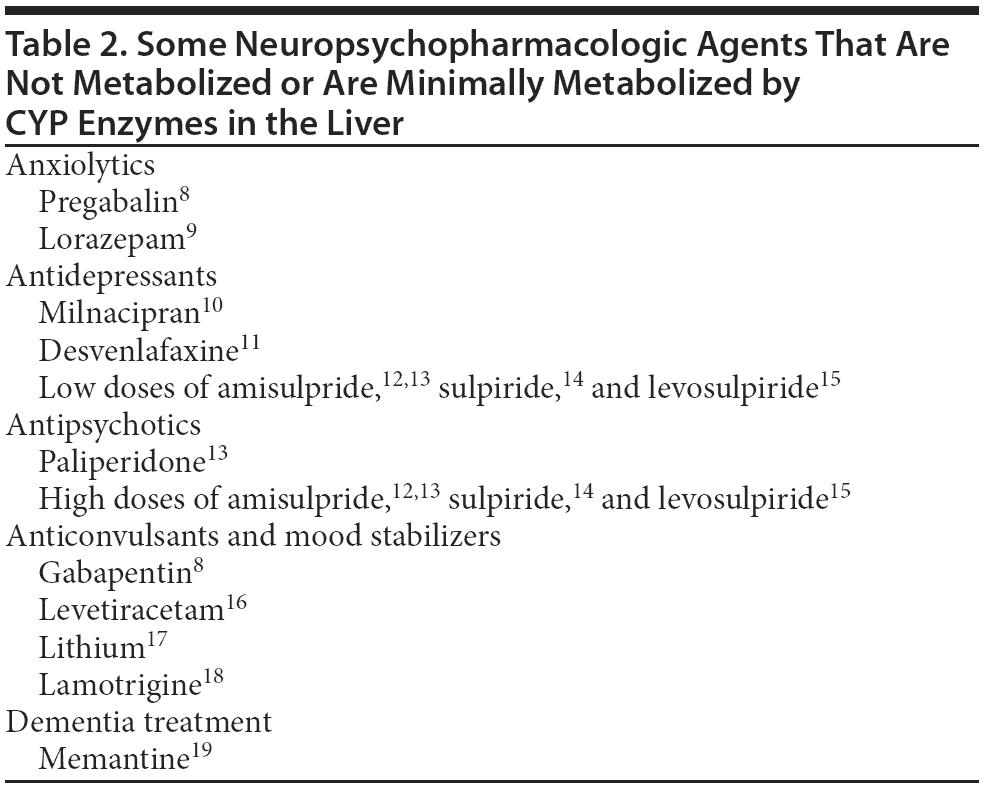Because this piece has no abstract, we have provided for your benefit the first 3 sentences of tahe full text.
There are several situations in which the hepatic metabolism of drugs may differ from that expected, resulting in possibly compromised efficacy or increased adverse effects. These situations are: When patients are slow or rapid metabolizers; when patients receive co-therapy with metabolic enzyme inducers or inhibitors; and when patients have impaired liver function. This article considers anxiolytic, antidepressant, antipsychotic, mood stabilizer, anticonvulsant, and anti-dementia drugs that are useful in such situations. A few metabolic drug interactions are briefly discussed.’ ‹
Notice of correction 1/8/2013: In Table 1, point 2 now correctly cites reference 22.

- In certain patients, hepatic metabolism of drugs is slower or more rapid than usual; consequences include an increased risk of adverse effects or diminished treatment efficacy.
- There are at least 5 important situations in which the hepatic metabolism of drugs is altered. These situations are briefly explained. If clinicians encounter such situations, they will need to make appropriate dose adjustments, or they can prescribe drugs that are not metabolized in the liver.
- Important neuropsychopharmacologic agents that are not metabolized in the liver are presented and briefly discussed.
In a recent case report,1 Paulzen and colleagues discussed the challenges they faced in treating a woman with psychotic depression who was found to be a cytochrome P450 (CYP) 2D6 ultrarapid metabolizer. She underwent many medication trials and eventually improved only after receiving sulpiride (300 mg/d), the action of which is terminated by renal excretion.
Patients who are abnormal metabolizers, who have liver disease, or who are taking drugs that induce or inhibit CYP enzymes necessitate an awareness of the few drugs in neuropsychopharmacology that are not metabolized by the CYP enzymes in the liver. Knowledge of possible treatment strategies, which may include dose adjustment or selection of drugs not metabolized by CYP enzymes in the liver, can be important in 5 situations in which hepatic metabolism of drugs differs from that expected (Table 1).
Adjusting the Dose
A knowledge of pharmacokinetics and drug interactions may guide dose adjustments in some situations; for example, low rather than standard doses of clomipramine are advisable if augmentation is desired in a patient who is already receiving fluoxetine (a CYP enzyme inhibitor).6
Selecting a Drug Not Metabolized by CYP Enzymes
As an alternative to dose adjustment, clinicians can prescribe drugs that are not metabolized or are only minimally metabolized by the CYP enzymes. A list of such drugs is presented in Table 2.
How Much Is the Drug Metabolized by the Liver?
It helps to know how much a drug is metabolized, if it is metabolized by the liver. For example, only about 20% of topiramate is metabolized in the liver; the remaining 80% is excreted unchanged. However, when enzyme-inducing drugs such as phenytoin or carbamazepine are administered, up to 50% of topiramate may be metabolized.20 Thus, topiramate may be a useful drug in certain, but not all, of the situations in Table 1.
Metabolism via Glucuronidation
Lorazepam and lamotrigine are possible candidates in many of the situations listed in Table 1. Lorazepam is metabolized by glucuronidation, but, because this pathway is relatively spared in liver disease,9 lorazepam is safer than diazepam or chlordiazepoxide in alcoholic patients with hepatic impairment.21 Lamotrigine is also metabolized predominantly by glucuronidation. Like lorazepam, it is vulnerable to factors that induce or impair glucuronidation.18
Selecting a Drug With an Active Metabolite Not Further Metabolized by the Liver
Finally, drugs that have active metabolites that are not further metabolized by the liver can be appropriate in patients who are rapid metabolizers and in those who are receiving CYP enzyme inducers. For example, risperidone (which is metabolized to 9-hydroxyrisperidone, or paliperidone)13 can be considered rather than olanzapine in a schizophrenia patient who is a heavy smoker.7 (For more on how smoking affects metabolism of antipsychotics, see my June column on the topic.) Another example (which could have benefited the patient described by Paulzen et al1) is venlafaxine; this antidepressant is metabolized to desvenlafaxine.11 The actions of paliperidone and desvenlafaxine are terminated principally by renal excretion.11,13
Conclusion
The hepatic metabolism of most neuropsychopharmacologic agents may be altered in various situations, such as when patients also receive drugs that influence the CYP enzymes responsible for drug metabolism or when they smoke or have liver disease. Consequences of altered drug metabolism include compromised medication efficacy or increased medication adverse effects. Corrective measures include appropriate dose adjustments or the use of medications that are not metabolized or are minimally metabolized by the CYP enzymes in the liver.
J Clin Psychiatry 2012;73(7):e889-e890 (doi:10.4088/JCP.12f07726)
© Copyright 2012 Physicians Postgraduate Press, Inc.
 Each month in his online column, Dr Andrade considers theoretical and practical ideas in clinical psychopharmacology with a view to update the knowledge and skills of medical practitioners who treat patients with psychiatric conditions.
Each month in his online column, Dr Andrade considers theoretical and practical ideas in clinical psychopharmacology with a view to update the knowledge and skills of medical practitioners who treat patients with psychiatric conditions.
Department of Clinical Psychopharmacology and Neurotoxicology, National Institute of Mental Health and Neurosciences, Bangalore, India ([email protected]).
Financial disclosure and more about Dr Andrade.
REFERENCES
1. Paulzen M, Tauber SC, Kirner-Veselinovic A, et al. Cytochrome P450 2D6 polymorphism and its impact on decision-making in psychopharmacotherapy: finding the right way in an ultrarapid metabolizing patient. J Clin Psychiatry. 2011;72(11):1465-1467. PubMed doi:10.4088/JCP.11cr07119
2. Ingelman-Sundberg M. Genetic polymorphisms of cytochrome P450 2D6 (CYP2D6): clinical consequences, evolutionary aspects and functional diversity. Pharmacogenomics J. 2005;5(1):6-13. PubMed doi:10.1038/sj.tpj.6500285
3. Zhou SF. Drugs behave as substrates, inhibitors and inducers of human cytochrome P450 3A4. Curr Drug Metab. 2008;9(4):310-322. PubMed doi:10.2174/138920008784220664
4. Spina E, Pisani F, Perucca E. Clinically significant pharmacokinetic drug interactions with carbamazepine: an update. Clin Pharmacokinet. 1996;31(3):198-214. PubMed doi:10.2165/00003088-199631030-00004
5. Villeneuve JP, Pichette V. Cytochrome P450 and liver diseases. Curr Drug Metab. 2004;5(3):273-282. PubMed doi:10.2174/1389200043335531
6. Andrade C. Fluoxetine, risperidone and seizures. Indian J Psychol Med. 1999;22:61-63.
7. Lowe EJ, Ackman ML. Impact of tobacco smoking cessation on stable clozapine or olanzapine treatment. Ann Pharmacother. 2010;44(4):727-732. PubMed doi:10.1345/aph.1M398
8. Bockbrader HN, Wesche D, Miller R, et al. A comparison of the pharmacokinetics and pharmacodynamics of pregabalin and gabapentin. Clin Pharmacokinet. 2010;49(10):661-669. PubMed doi:10.2165/11536200-000000000-00000
9. Charney DS, Mihic SJ, Harris RA. Hypnotics and sedatives. In: Hardman JG, Limbird LE, Gilman AG, eds. Goodman and Gilman’s The Pharmacological Basis of Therapeutics. 10th ed. New York, NY: McGraw-Hill, 2001:399-427.
10. Puozzo C, Albin H, Vinçon G, et al. Pharmacokinetics of milnacipran in liver impairment. Eur J Drug Metab Pharmacokinet. 1998;23(2):273-279. PubMed doi:10.1007/BF03189351
11. Andrade C. Desvenlafaxine. Indian J Psychiatry. 2009;51(4):320-323. PubMed doi:10.4103/0019-5545.58303
12. Rosenzweig P, Canal M, Patat A, et al. A review of the pharmacokinetics, tolerability and pharmacodynamics of amisulpride in healthy volunteers. Hum Psychopharmacol. 2002;17(1):1-13. PubMed doi:10.1002/hup.320
13. Urichuk L, Prior TI, Dursun S, et al. Metabolism of atypical antipsychotics: involvement of cytochrome p450 enzymes and relevance for drug-drug interactions. Curr Drug Metab. 2008;9(5):410-418. PubMed doi:10.2174/138920008784746373
14. Caley CF, Weber SS. Sulpiride: an antipsychotic with selective dopaminergic antagonist properties. Ann Pharmacother. 1995;29(2):152-160. PubMed
15. Mucci A, Nolfe G, Maj M. Levosulpiride: a review of its clinical use in psychiatry. Pharmacol Res. 1995;31(2):95-101. PubMed doi:10.1016/1043-6618(95)80053-0
16. Carreno M. Levetiracetam. Drugs Today (Barc). 2007;43(11):769-794. PubMed doi:10.1358/dot.2007.43.11.1136902
17. Andrade C. Psychopharmacology. In: Bhugra D, Ranjith G, Chaturvedi SK, eds. Handbook of Psychiatry: A South Asian Perspective. 2nd ed. New Delhi, India: Byword Viva. In press.
18. Johannessen Landmark C, Patsalos PN. Drug interactions involving the new second- and third-generation antiepileptic drugs. Expert Rev Neurother. 2010;10(1):119-140. PubMed doi:10.1586/ern.09.136
19. Jarvis B, Figgitt DP. Memantine. Drugs Aging. 2003;20(6):465-476. PubMed doi:10.2165/00002512-200320060-00005
20. Bourgeois BF. Pharmacokinetics and metabolism of topiramate. Drugs Today (Barc). 1999;35(1):43-48. PubMed
21. Kumar CN, Andrade C, Murthy P. A randomized, double-blind comparison of lorazepam and chlordiazepoxide in patients with uncomplicated alcohol withdrawal. J Stud Alcohol Drugs. 2009;70(3):467-474. PubMed
22. Zhou S-F, Liu J-P, Chowbay B. Polymorphism of human cytochrome P450 enzymes and its clinical impact. Drug Metab Rev. 2009;41(2):89-295. PubMed doi:10.1080/03602530902843483
Related Articles/Bibliography
1. Lobello KW, Preskorn SH, Guico-Pabia CJ, et al. Cytochrome P450 2D6 phenotype predicts antidepressant efficacy of venlafaxine: a secondary analysis of 4 studies in major depressive disorder. J Clin Psychiatry. 2010;71(11):1482-1487. PubMed doi:10.4088/JCP.08m04773blu
2. Desmarais JE, Looper KJ. Interactions between tamoxifen and antidepressants via cytochrome P450 2D6. J Clin Psychiatry. 2009;70(12):1688-1697. PubMed doi:10.4088/JCP.08r04856blu
3. Sit DK, Perel JM, Helsel JC, et al. Changes in antidepressant metabolism and dosing across pregnancy and early postpartum. J Clin Psychiatry. 2008;69(4):652-658. PubMed doi:10.4088/JCP.v69n0419
4. Melkersson KI, Scordo MG, Gunes A, et al. Impact of CYP1A2 and CYP2D6 polymorphisms on drug metabolism and on insulin and lipid elevations and insulin resistance in clozapine-treated patients. J Clin Psychiatry. 2007;68(5):697-704. PubMed doi:10.4088/JCP.v68n0506
5. de Leon J, Susce MT, Pan R-M, et al. The CYP2D6 poor metabolizer phenotype may be associated with risperidone adverse drug reactions and discontinuation. J Clin Psychiatry. 2005;66(1):15-27. PubMed doi:10.4088/JCP.v66n0103
6. Berle JO, Steen VM, Aamo TO, et al. Breastfeeding during maternal antidepressant treatment with serotonin reuptake inhibitors: infant exposure, clinical symptoms, and cytochrome p450 genotypes. J Clin Psychiatry. 2004;65(9):1228-1234. PubMed doi:10.4088/JCP.v65n0911
This PDF is free for all visitors!
Vol 86 • 2025 • Number 4
Read the Current Issue
Original Research
Effects of Interpersonal and Social Rhythm Therapy on Suicidal Ideation in Adults with Bipolar II Depression
Academic Highlights
Real-World Implementation of Xanomeline-Trospium in Schizophrenia: A Consensus Panel Report
Academic Highlights
Psychosocial Interventions and Functional Recovery in Schizophrenia
Original Research
Symptom Network Analysis of ADHD and Emotional Symptoms in Adults
Original Research
Emory Treatment Resistance Interview for PTSD—Short Version
Original Research







